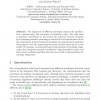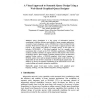ESWS
2008
Springer
14 years 1 months ago
2008
Springer
The traditional strategy performed by Information Retrieval (IR) systems is ranked keyword search: For a given query, a list of documents, ordered by relevance, is returned. Releva...
ESWS
2008
Springer
14 years 1 months ago
2008
Springer
Abstract. The Semantic Desktop is a means to support users in Personal Information Management (PIM). It provides an excellent test bed for Semantic Web technology: resources (e. g....
ESWS
2008
Springer
14 years 1 months ago
2008
Springer
In the semantic web environment, where several independent ontologies are used in order to describe knowledge and data, ontologies have to be aligned by defining mappings among the...
ER
2008
Springer
14 years 1 months ago
2008
Springer
Abstract. The alignment of different ontologies requires the specification, representation and execution of translation rules. The rules need to integrate translations at the lexic...
EKAW
2008
Springer
14 years 1 months ago
2008
Springer
Query formulation is a key aspect of information retrieval, contributing to both the efficiency and usability of many semantic applications. A number of query languages, such as SP...
EDBT
2008
ACM
14 years 1 months ago
2008
ACM
The goal of the Semantic Web is to support semantic interoperability between applications exchanging data on the web. The idea heavily relies on data being made available in machi...
ECAI
2008
Springer
14 years 1 months ago
2008
Springer
Automation of Web service composition is one of the most interesting challenges facing the Semantic Web today. Since Web services have been enhanced with formal semantic descriptio...
REST
2010
ACM
14 years 1 months ago
2010
ACM
In this article a formal model applying REST architectural principles to the description of semantic web services is introduced, including the discussion of its syntax and operati...
CIVR
2008
Springer
14 years 1 months ago
2008
Springer
As the consequence of semantic gap, visual similarity does not guarantee semantic similarity, which in general is conflicting with the inherent assumption of many generativebased ...
APWEB
2008
Springer
14 years 1 months ago
2008
Springer
Resource searching in the current peer-to-peer (P2P) applications is mainly based on the keyword match. However, more and more P2P applications require an efficient semantic search...



